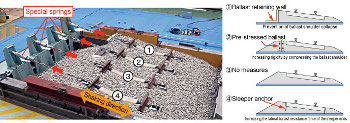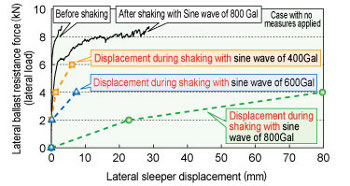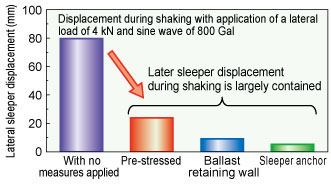5. Measures against buckling of ballasted track during earthquakes
As seismic motion is acting on ballasted track, lateral ballast resistance force falls, causing track panels to buckle easily. During hot periods over the summer, rail temperature (axial force) rises increasing the lateral force which can lead to track buckling, and consequently further reducing track buckling stability during seismic activity. At the same time, no method has yet been established to assess the track buckling stability during earthquakes, making it difficult to evaluate the effectiveness of measures taken.
A test method was developed using special springs with small tensile load variation whereby the lateral load on the sleeper can be maintained even during shaking. Tests on a large scale shaking rig demonstrated that it was possible to quantitatively evaluate the track buckling stability of various anti-buckling measures, through indices based on lateral sleeper displacement (Figure 1).
Indoor tests at RTRI showed that lateral ballast resistance force greatly decreased during shaking, and when axial forces of rails (lateral direction loads) were high, lateral sleeper displacement was also significant (Figure 2). It was then possible to confirm that anti-buckling measures did indeed reduce lateral sleeper displacement significantly. It was found in tests that the sleeper anchor was the most effective of all the tested measures, reducing lateral sleeper displacement by a tenth under this test conditions (Figure 3).
Other Contents
- 1. Seismic ground motion simulator applicable to M9 earthquakes
- 2. Seismic Hazard simulator for railways
- 3. Early warning system employing ocean bottom seismometer data
- 4. Development of Railway Embankment Structures Resistant to severe Earthquakes and Prolonged Overflows caused by Tsunamis
- 5. Measures against buckling of ballasted track during earthquakes
- 6. Disaster Hazard Mapping Technology
- 7. Method for diagnosing condition of concrete roadbed in tunnels
- 8. Analytical method for evaluating carbody safety aimed at reducing passenger injury in case of level crossing collisions
- 9. Bogie to control decrement in wheel load
- 10. Mechanical pneumatic steering system with failsafe function
- 11. Gear oil for Shinkansen trains with improved startability in low temperature conditions
- 12. Process to select appropriate sounds to convey in-cab driver alerts
- 13. Training in communication techniques for train dispatchers in disrupted situations
- 1. Seismic ground motion simulator applicable to M9 earthquakes
- 2. Seismic Hazard simulator for railways
- 3. Early warning system employing ocean bottom seismometer data
- 4. Development of Railway Embankment Structures Resistant to severe Earthquakes and Prolonged Overflows caused by Tsunamis
- 5. Measures against buckling of ballasted track during earthquakes
- 6. Disaster Hazard Mapping Technology
- 7. Method for diagnosing condition of concrete roadbed in tunnels
- 8. Analytical method for evaluating carbody safety aimed at reducing passenger injury in case of level crossing collisions
- 9. Bogie to control decrement in wheel load
- 10. Mechanical pneumatic steering system with failsafe function
- 11. Gear oil for Shinkansen trains with improved startability in low temperature conditions
- 12. Process to select appropriate sounds to convey in-cab driver alerts
- 13. Training in communication techniques for train dispatchers in disrupted situations



